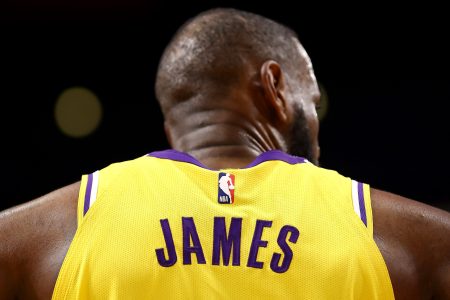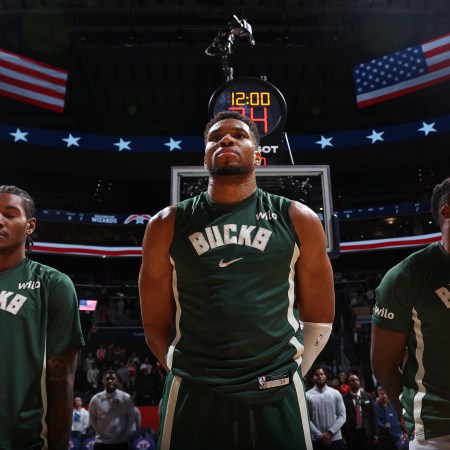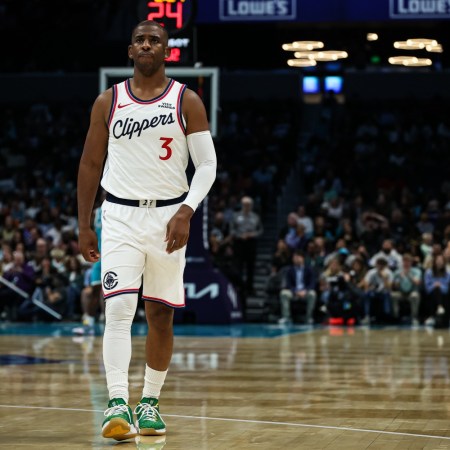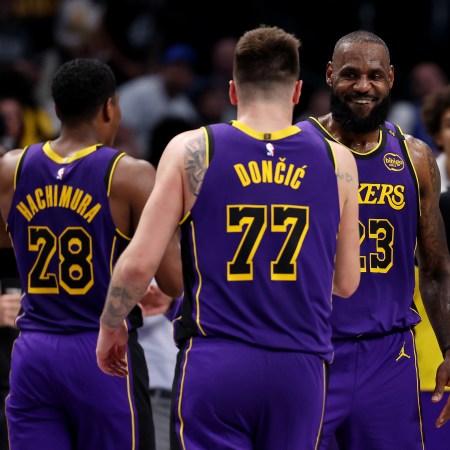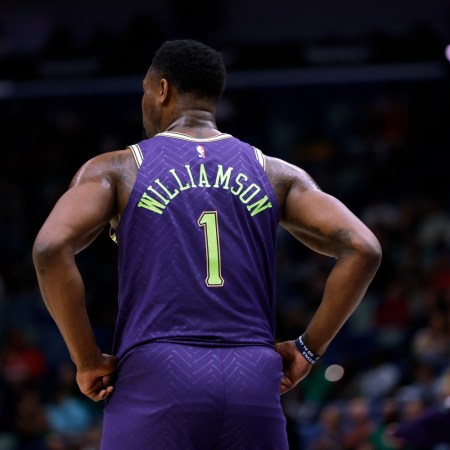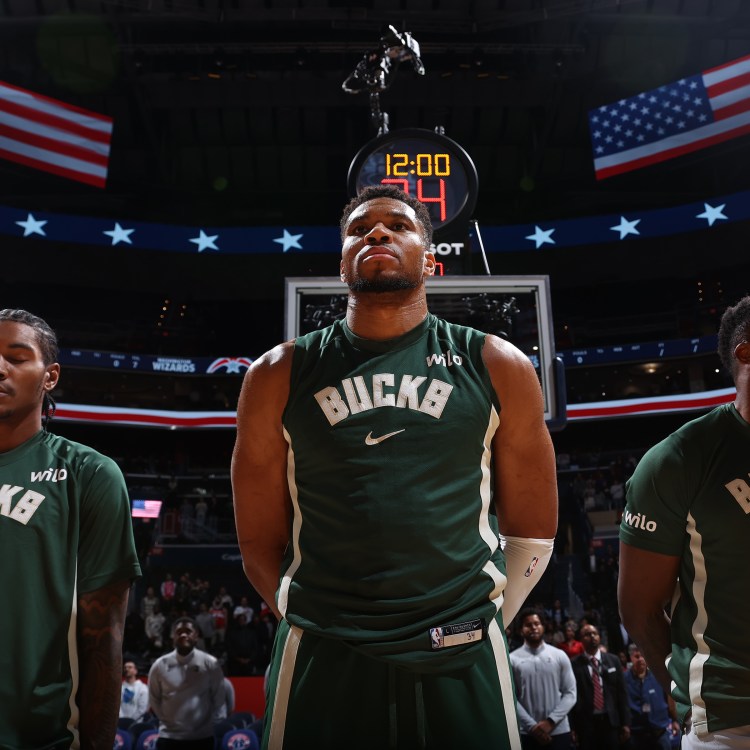With his team trailing the Knicks by three points with 15 seconds on the clock in an elimination game, Philadelphia guard Tyrese Maxey dribbled just past halfcourt and considered his options. Feeling it after completing a four-point play moments earlier, the 23-year-old decided his best option was himself and pulled up for a 35-foot bomb with his feet still touching the logo at the center of Madison Square Garden. Maxey’s decision was the right one. Swish.
Once almost unfathomable, Maxey’s firing from that location has almost become par for the course in today’s NBA as players are taking, and making, long-range shots from the deepest depths of 3-point land with increasing frequency.
Kirk Goldsberry, the bestselling author of Sprawlball and one of the leading experts in basketball analytics, digs into how shots like the one Maxey buried against the Knicks have become nearly commonplace in The Association in his new book Hoop Atlas: Mapping the Remarkable Transformation of the Modern NBA. According to Goldsberry, who is a professor and the executive director of the Business Of Sports Institute at the University of Texas at Austin, the shot that Maxey made last week is a distant relative of a jumper that Michael Jordan nailed more than four decades ago.
“It starts with Michael’s game-winning jumper against Georgetown in the 1982 NCAA championship. Not only did Michael win the game, he looked cooler than anybody doing it,” Goldsberry tells InsideHook. “I think that inspired players like Kobe Bryant and Allen Iverson to pick up the ball and start shooting jumpers. Kobe and Allen inspired people like Kyrie Irving, James Harden and Stephen Curry. You can draw a clean line from Michael through Iverson and Kobe to Stephen. The shot we saw from Tyrese Maxey was normalized by Curry over the last decade. One of the things Stephen should remain known for for the rest of time is he changed the definition of an acceptable jump shot. The kind of shot Maxey hit was unacceptable from that distance just 10 or 15 years ago. That’s the sort of lineage or multi-generation inspiration that’s at the heart of this Hoop Atlas project.”
What else does Goldsberry’s Hoop Atlas contain and why did he write it? We asked him.
InsideHook: What was your reasoning for writing and releasing this book at this juncture in NBA history?
Kirk Goldsberry: I decided to write Hoop Atlas because one of the most interesting and drastic changes in sports in my lifetime has been the metamorphosis in the NBA. I’ve been obsessed with it and I feel I’m in a pretty good position to capture some key elements of that metamorphosis and describe them to readers. I wanted to capture this incredible story in the way I study the game, which is very visual and spatial. There’s also a story about changing the conversation around the greatness of superstars. When you study greatness in art or music, you get a much more nuanced appreciation of greatness. A lot of it has to do with how icons influence the generations to come. One thing I saw that was absent in the constant discussion of NBA greatness, particularly in the context of the modern NBA, was how Michael Jordan, Allen Iverson or Dirk Nowitzki not only dominated the game, but influenced and changed it forever.
IH: Is basketball unique in that a single player can have such a large influence over an entire sport?
KG: Yes. If you look at Stephen Curry, he changed basketball forever. If you go to the playground, you’ll see a bunch of kids shooting like Stephen trying to be him. He’s changed the NBA and changed youth basketball, as we’ve seen with Caitlin Clark. I think the nature of basketball does lend itself more to those iconoclastic disruptive individual star players. What this book tries to capture is who those people are over the last 30 years. Nobody’s been bigger in that regard than Michael Jordan, who elevated the game and made jump shooting and perimeter play cool and showed guards could win scoring titles and MVPs and ultimately NBA championships. He inspired a future generation of players like Kobe Bryant, Tracy McGrady and Allen Iverson to dominate the game in cool new ways.
IH: Due to the Jumpman logo, many associate Jordan with dunking. But you think he inspired shooters as well?
KG: I think there were two Michael Jordans. There was Air Jordan in the ’80s and then there was jump-shot Jordan in the later part of his career. Michael developed the most unstoppable game in the post of any guard in the history of the league and it featured endless jump shots. One of the cool things we were able to do with this project was to quantify how efficient he was in different parts of the court. They didn’t start collecting some of the shooting data until 1996, the year he won his fifth championship. We were able to go back and see just how good Michael was at shooting through today’s nerdy lenses. This dude was not only the most active shooter and scorer in the NBA, but was also arguably the most efficient volume jump shooter too. He made it cool and won because he combined volume and efficiency in ways we now appreciate in the 2020s. By the end of his career, he’d proven shooting guards could win MVP, which no shooting guard had ever done, and that a jump-shooting, perimeter-oriented player could win scoring titles and NBA championships with fadeaways and pull-ups.
IH: How impactful on the court in today’s NBA is the Jordan-inspired focus on jump shots instead of lay-ups?
KG: The game is more open. Go watch a Larry Bird game from the ’80s and it almost looks like clowns in a taxi cab. There’s a bunch of dudes in the paint just with no airspace. Turn on a game tonight and you’ll see offenses with five dudes behind the 3-point line. It’s opened up the sport and it’s made it faster. The passes travel further and ball movement has increased. The jump-shooting is more difficult, but these guys are more skilled than ever. It’s also opened up better driving corridors toward the hoop, which increases our likelihood of seeing Anthony Edwards fly in for an incredible dunk that melts our faces online for days to come. It’s made it more open and fun.
LeBron James Is the Protagonist of Two Conflicting American Tales
An excerpt from Valerie Babb’s “The Book of James: The Power, Politics, and Passion of LeBron”IH: So you find the NBA more aesthetically pleasing now than you did during Jordan’s playing days?
KG: To an extent. Everybody romanticizes the ’90s Knicks, but go watch a Knicks game that wasn’t against Michael Jordan. It’s not that entertaining, in my opinion. I think the 3-point line, pace and space have made the league more entertaining to be sure, but I think we’re rapidly approaching a point, if we’re not already there, where it might be too much of a good thing with too many threes and not enough defensive excellence. Ultimately, I think this movement has made the game better to watch, but I wonder if it’s heading towards a time I won’t answer that the same way.
IH: What’s the biggest takeaway you’d like readers of the book to get from reading it?
KG: NBA teams love to memorialize the legacies of their best players and the teams up in the rafters. What I’m trying to challenge the readers with here is that the best legacies in this sport are found on the floor. To watch players like Tyrese Maxey and understand how their best moments are standing on the shoulders of their basketball superstar ancestors. True greatness is evolving the game and players that are bringing that evolution to the game at the highest levels, to me, deserve to be recognized as the greatest players of all time.
The Charge will help you move better, think clearer and stay in the game longer. Subscribe to our wellness newsletter today.

